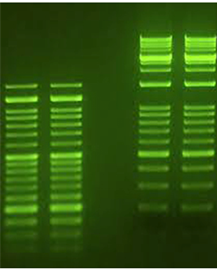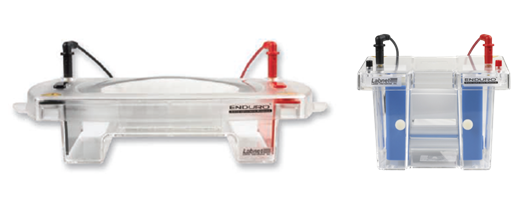Gel electrophoresis is the process of using an electrical current to separate charged particles according to their molecular weight and structure as they are pulled through a gel medium.
As the ions move through the gel, they form bands which are analyzed and reveal insights into the nature of the samples being measured.

Two commons forms of electrophoresis are DNA and protein gel electrophoresis.
DNA gel electrophoresis is performed using horizontal gel tanks and a medium of agarose, while protein gel electrophoresis is done in vertical tanks using polyacrylamide gels.

Gel electrophoresis tanks require an electrode at either end and casting equipment for forming the gel, including “combs” that create a “well” in the gel where the sample is loaded.
A power supply is also needed. When connected to the electrodes, the power supply creates an electric field in which the migration of the charged particles through the gel occurs.
Which power supply to choose for gel electrophoresis depends on the application.
Here are answers to several common questions we receive about power supplies for gel electrophoresis:
What voltage should I choose for gel electrophoresis?
When running agarose electrophoresis, 10V per centimeter of distance between electrodes is standard. The longer the gel, the higher the voltage.
When using a 10cm long gel tank, use 100V of power; when using a 20cm long tank, use 200V.
Higher voltage may be needed for specialty applications like iso electric focusing and sequencing.
Semi-dry blotting and protein gels larger than 10x10cm require higher amperage power supplies as well.
When do I select constant voltage and when do I want to choose constant current settings?
Most electrophoresis gels are run using constant voltage.
Keeping in mind Ohms law that V=IR (Voltage = Current x Resistance), even if the resistance of the buffer and gel change, the voltage will remain constant.
In situations where the resistance of the buffer will lower over time, then constant current is the better setting to prevent the gel from overheating and producing poor results.
There are pros and cons to both of these. Constant voltage results in less heat generation, but the run times are longer and the bands may be more diffuse.
Constant current provides a steady run rate and sharper bands, but more heat is produced that can lead to damage to samples and safety issues.
In both cases, the gels need to be monitored during a run.
Do I need a gel electrophoresis power supply with multiple outputs?
Multiple outputs are required when running more than one gel tank at a time, possibly in situations where a single gel cannot resolve enough samples at a time.
Keep in mind the same settings will apply to both tanks and higher amperage/current is needed to run more than one gel at a time.
What are key safety features to look for in a gel electrophoresis power supply?
A quality power supply for electrophoresis will come with safety features to protect the scientist, the device, and features to protect the gel as well
Over-power limit detection prevents both the user and the gel in the event of a power surge while no-load detection cuts off the power if the device is not in use and reduces wear on the circuits.
An automatic countdown timer shuts off the power and allows the gel to be run without the technician “babysitting” with a manual timer in hand.
With up to 300V of power and four outputs, the myVolt Touch can run both DNA and protein gels.
The myVolt Touch has a touchscreen control panel that automatically changes the orientation to be viewable whether horizontal or vertical.
This convenient feature allows the myVolt Touch to conserve precious benchtop or shelf space.
Stellar Scientific offers power supplies for gel electrophoresis like the myVolt touch and supplies for preparing and running DNA and protein gels.


